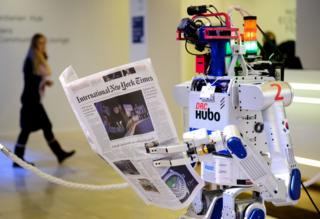 As we step into the new year, many uncertainties loom before us. For many, president-elect Trump holds a promise for a better future. Others fear this change. But even those who are hopeful surely see that bringing back industry will not be an easy, if at all a possible feat, that the economy will be difficult to revive, and that global instability is hitting unprecedented heights.
As we step into the new year, many uncertainties loom before us. For many, president-elect Trump holds a promise for a better future. Others fear this change. But even those who are hopeful surely see that bringing back industry will not be an easy, if at all a possible feat, that the economy will be difficult to revive, and that global instability is hitting unprecedented heights.
Something of importance has passed from the world with 2016, along with the many celebrities and public personas that have left us. It was a certain feeling that we knew our world and our realities.
Be the first to know – Join our Facebook page.
The coming year feels much more like unknown territory than ever before. Merriam-Webster Dictionary’s word of the year for 2016 was « surreal. » With Brexit, Trump, the shocking terror attacks we have seen, and the many other incidents that took people by surprise, for better or worse, there is a sense that the very rules of the game that we had come to know, are changing.
This shift in our lives may seem scary, but it actually heralds a profound positive transformation. In Hebrew, the word “ mashber ” (crisis) also denotes the place of birth. It signifies that when things seem to be falling apart, it is a sign that something new wants to take their place. Now is exactly that time.
Evolution in the Works
Despite common thought, human evolution has not ended. In their book , The Ten Thousand Year Explosion , Gregory Cochran and Henry Harpending wrote of how culture has increased human evolution: “Human evolution did not stop when anatomically modern humans appeared, or when they expanded out of Africa. It never stopped—and why would it?” They explain that culture is often defined as artistic expression, science, technology, morals and laws, for example; but can also be defined as shared, learned social behavior. From their perspective, humans are a species so dependent on culture and technology that cultural adaptation has replaced biological adaptation.
Over the decades, humans have gone through enormous incremental cultural changes at a constantly accelerating pace. Yet we now witness the end of an era. Something in our cultural development seems to have been slowing down and gradually coming to a halt. Human egoism, our desire to progress, conquer, and succeed – the very engine that has been driving us forward- has run its course.
We cannot develop further through the same form of competition. This is evident with the younger generations that have lost the motivation of their predecessors to succeed and advance in the career world. The pleasure derived from work is diminishing, as well as the desire to marry and have children. As our culture becomes a consumerism stricken addiction to smartphones, while depression , anxiety and loneliness are skyrocketing, there is a great loss of meaning in life. Many find refuge in drugs, so it is no wonder governments themselves are working to legalize them to avoid the chaos that a bored, misguided, and frustrated public would inflict upon society.
The Path Beneath Our Feet
The world is searching for a new path. However, it cannot be found on the same level we are on now. The truth of the ineffectiveness of all previous methods for achieving our common goals is being revealed with great intensity. We have been publicly acknowledging the grand failure of liberal democracy to achieve the equality, cohesion and harmony it promised to achieve in our societies. The failure of capitalism to provide opportunities for all is evident with the constantly growing economic gaps. The failure to achieve continued economic growth, while preserving our planet and ecosystem is bringing us to the brink of a climate catastrophe , and then there is the failure to achieve international cooperation to deal with the many security issues that are at hand… and the list goes on.
Much like the caterpillar that has eaten all it could and then cocoons itself in a dark and cramped space, where its old form disintegrates to become the nourishment and building blocks for an entirely new creature to emerge, so is humanity now experiencing the end of its egoistic developmental stage. The cocoon is dark and so too does our future seem uncertain, as our institutions break down. However, despite the gloom of the situation, the blueprints for our imminent, improved form already exist.
Within the amorphous soup of the self-digested caterpillar are certain highly organized groups of cells, known as “imaginal discs”, which survive the digestive process. These cells become the organs of the butterfly, a completely new creature. Humanity too, is on the brink of discovering a new form in its evolution. Yet, unlike the caterpillar, it must consciously achieve it.
In 2017 It’s Connection, or Else…
Evolutionary biologist, Dr. Elisabet Sahtouris, explains that there is a repeating pattern in evolution where aggressive competition leads to the threat of extinction, which is then avoided by the formation of cooperative alliances. In nature, new forms appear through the connection of molecules and organisms that did not connect in the same way before. To move forward, humanity must emulate nature and discover its new form, through new connections between its parts.
So far, we have seen attempts to form “unions”, such as the EU, that have proven false. These have been unities of banks, hegemonies of wealth and power, but none have successfully attempted to create actual unity between people. We have been sold a concept of unity that only serves the elites. Those who do not belong to the upper thousandth percentile went along with it, as they were conned to see the world through the warped brainwash of bought media. However, the natural process of development that humanity is undergoing will still have its way.
Just as the Russian attempt to force communism on their people didn’t last, America and every other nation in the world will not succeed, until they understand nature’s law of evolution through connection. The only way to repair the economy, politics, culture, education, families and everything else in our society that needs change is through the true healing of human relations.
Postponing this solution is dangerous, for when the stress between our behavior and the natural course of evolution becomes too great, we find ourselves in crisis that is hard to escape. A revolution comes along or a war, to somehow shift the order.
Education Is Key
To step onto the right track, we need to learn from societies that have managed to form the connection between people that is now necessary for humanity. For centuries, Jews have focused on education that would create thriving societies that contain mutual support, trust, and positive development. Often overlooked, Jewish wisdom is steeped in teachings of unity and love. Rabbi Nachman wrote, “The essence of life and existence, and correction of all of creation is in people of different opinions integrating together in love, unity and peace” Likutey Halachot (Assorted Rules).
The nation of Israel was originally founded in ancient Babylonian times, around the study of how to « love others as yourself ». Before they gathered around Abraham to receive this teaching, they were just ordinary Babylonians, living their simple, natural lives. Under Abraham they underwent a process that molded them into people who knew themselves and understood others; that knew how to treat each other, how to treat nature, animals, trees and the world around them.
Principles of how to relate correctly to others and to the world at large became unique attributes of this great ancient culture. They include learning how to avoid criticism of others, how to help others through example, without coercion, as is written: « do not judge your fellow man until you have been in his position » ( Pirkei Avot 2:5 ). Teachings were unique to each individual, as implied in the instruction to, « Train a child in the way he should go » ( Proverbs 22:6 ), bringing each individual to fulfill their potential in the best way possible for the benefit of the whole.
In our culture, we are not taught to rise above our self- centered nature; but the people of Israel were taught how to be connected « as one man with one heart », and to care for one another in mutual guaranty. It demanded practice, which began at a very young age and lasted throughout their lifetime. The entire nation underwent this process in the days of Abraham and later with Moses during the 40 years in the desert. Only when they were completely ready to unite as one nation, did they enter the land of Israel.
Before the destruction of the Temple, the people of Israel thrived in an atmosphere of mutual care; but even after the great exile, the foundations and practices they managed to maintain allowed them to survive even the most difficult hardships.
Though its original form was forgotten by most of the Jewish people, many have been calling to revive the method that is also referred to as « the internality of Torah », not only for the sake of Israel, but also for the sake of humanity. Rabbi Kook wrote, « The exile decreased our unique character and oppressed us, but it did not destroy even a fraction of our true qualities. All that we were is still with us, all that needs to be great though small, withered and worn out, shall grow and blossom once more » ( Orot p. 84).
This practical method of connection, which was never intended for the Jewish people alone, has been awaiting these very times to help humanity make the evolutionary leap it must make. The Jewish people were « chosen » to be a prototype, the imaginal discs that would open up a new form for humanity’s existence when the time was ripe.
The Year Ahead
As the world advances without real connection, it will reach a bursting point and will come to Israel in demand. Israel must begin to live up to its forgotten destiny and export its educational startup, and fast. I believe that the common threat of terrorism will be one major force that drives humanity to connect in the near future. However, the path to actualize positive change in the coming year and the ones to follow must come through education, and our willingness to grasp where our natural evolution is leading us.
Michael Laitman is a Professor of Ontology, a PhD in Philosophy and Kabbalah, an MSc in Medical Bio-Cybernetics, and was the prime disciple of Kabbalist, Rav Baruch Shalom Ashlag (the RABASH). He has written over 40 books, which have been translated into dozens of languages. Click Here to visit his author page.
Relevant to your professional network? Please share on Linkedin
Think others should know about this? Please share
| |
© Source: http://www.jpost.com/Opinion/Why-the-world-depends-on-Jewish-education-in-2017-477522
All rights are reserved and belongs to a source media.
 Wong was born in Tianjin, China in 1925. He launched his career in Hong Kong after moving there in 1956. Originally drawn as a means to support his family, his comic strips went on to become hugely influential among Chinese-speaking communities around the world.
Wong was born in Tianjin, China in 1925. He launched his career in Hong Kong after moving there in 1956. Originally drawn as a means to support his family, his comic strips went on to become hugely influential among Chinese-speaking communities around the world. 

 Visitors have been enjoying a new floating walkway on the Hongshui River in China’s Guizhou Province.
Visitors have been enjoying a new floating walkway on the Hongshui River in China’s Guizhou Province. 
 British number one Johanna Konta continued her good start to 2017 by reaching the semi-finals of the Shenzhen Open in China.
British number one Johanna Konta continued her good start to 2017 by reaching the semi-finals of the Shenzhen Open in China. 
 SEOUL, Jan. 5 (UPI) — Chinese Foreign Minister Wang Yi voiced his opposition to the deployment of a U. S. missile defense system on the Korean peninsula during a meeting with South Korea opposition party lawmakers in Beijing on Wednesday.
SEOUL, Jan. 5 (UPI) — Chinese Foreign Minister Wang Yi voiced his opposition to the deployment of a U. S. missile defense system on the Korean peninsula during a meeting with South Korea opposition party lawmakers in Beijing on Wednesday. 
 China’s yuan climbed at its fastest pace against the greenback in a year in offshore trade Thursday, offering some relief to a currency bedeviled by capital outflow concerns recently.
China’s yuan climbed at its fastest pace against the greenback in a year in offshore trade Thursday, offering some relief to a currency bedeviled by capital outflow concerns recently. 


 In 2009 a court ordered the state to create and implement an awareness programme for muthi market wildlife trade – but almost seven years on its still being conceptualised.
In 2009 a court ordered the state to create and implement an awareness programme for muthi market wildlife trade – but almost seven years on its still being conceptualised. 
 New guidelines turning conventional wisdom on its head may help prevent life-threatening peanut allergies in future generations of children.
New guidelines turning conventional wisdom on its head may help prevent life-threatening peanut allergies in future generations of children. 
 Science fiction has long imagined a future in which humans are ousted from their jobs by machines.
Science fiction has long imagined a future in which humans are ousted from their jobs by machines. 

